Jump to:
Your curls are definitely unique, but all curl patterns will fall under one of 6 curl types. Find out what your exact curl type is in our informative guide. Plus, see custom styling and hair care tips for each type.
Wait, There Are Different Curl Types?
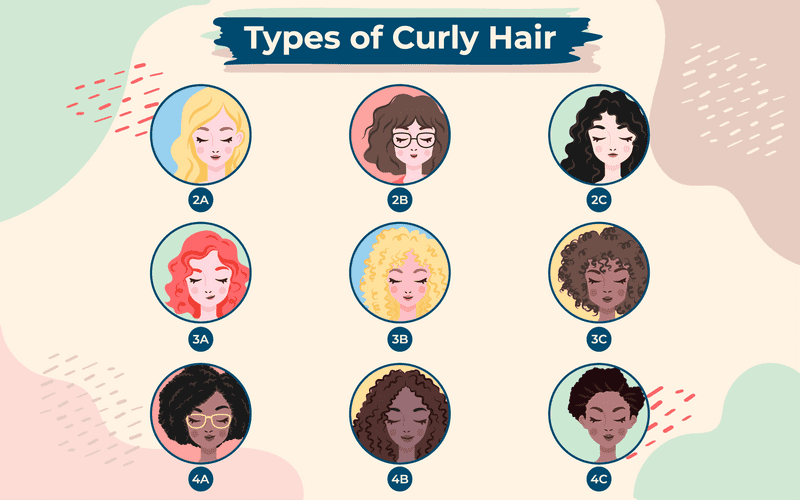
Ever taken an online quiz or personality test? It’s always entertaining to learn something new about ourselves, even if the results are just for fun.
What’s more fun than discovering your spirit animal is an arctic fox? Finding out what your curl type is, of course. And … it is valuable information you can actually benefit from!
If you have curly hair, you absolutely need to know what your curl type is. Paying attention to your curl type is the only way to pick the right products for your hair. It’s the key to designing a healthy hair care regimen to keep your locks looking fly.
And it ensures you know precisely what your hair needs and what you should avoid at all costs.
When you discover your curl type, you’ll view your locks in a new light. The only problem is that curl typing is notoriously difficult. Different curl patterns can look and feel very similar, making it harder to distinguish between them. But that’s not going to be a problem for you! We’ve laid out all six curl types below with a complete description and photos to make your curl ID much easier.
We’ve also tucked in some expert curl styling tips for each type! Keep reading to learn about the different curl types and how to determine which one your curls fall under.
Read Next: Hair Type Chart & How to Use It
Intro to the 6 Curl Types and Patterns
The world is filled with different hair types and textures, but for many years, we only knew to call them straight, wavy, curly, or coily.
Then, in the 90s, Oprah Winfrey’s stylist Andre Walker developed a revolutionary hair typing chart (very appropriately named The Andre Walker Hair Typing System). And that’s where our understanding of curls and curl patterns really began to deepen.
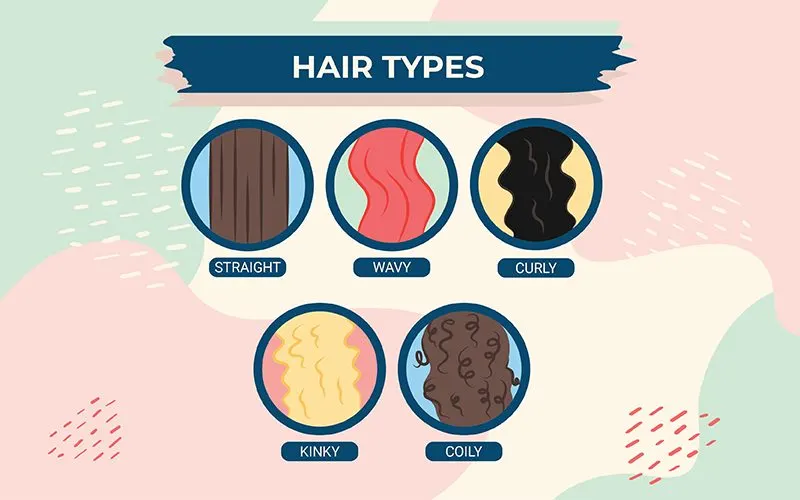
In the hair typing system, there are four general hair types:
- Type 1: Straight
- Type 2: Wavy
- Type 3: Curly
- Type 4: Coily or Kinky
Each of those four types is then broken down into subtypes A, B, and C. So, if you have pin-straight hair, you know you’re type 1. But you can further break it down into type 1A, 1B, or 1C depending on your hair’s texture and appearance.
Since we’re focusing on curly hair today, we’ll look at types 3 (curly) and 4 (coily or kinky). If you have curly hair, your hair type will begin with the number 3 or 4. The letter, or subtype, that comes after is what we’re about to determine.

Here’s a quick summary of the different subtypes for curly and coily/kinky hair:
- Type 3: Curly
- 3A: Lots of body with thick, defined but loose curls that tend to frizz
- 3B: Medium-sized tighter curls that may frizz
- 3C: Tight, corkscrew curls with an S-shape
- Type 4: Coily or Kinky
- 4A: Defined, tight coils with a definite O-shape
- 4B: Less defined coils with a Z-shape
- 4C: Super tight coil/kink pattern that may not look like curls
Even with these brief descriptions, it’s hard to determine which type your curls will actually fall under. That’s why we’re going to take a look at each curl type in depth.
Read through the different curl patterns and types below to see which one describes your locks!
What Is Type 3 Curly Hair?
Type 3 hair is unmistakably curly. Type 3 curls can look different based on your subtype, but overall, they are defined, bouncy curls with an S-shape. Type 3 includes curls that range from loose, soft ringlets to tight corkscrew curls.
Things you might notice about your type 3 hair:
- It’s not very shiny naturally
- Your curls have an S-shape
- Your curls are bouncy and defined
- You naturally have lots of body and volume
Now that you know about type 3 hair, let’s take a look at the more specific subtypes to find out if one of them describes your curl pattern.
Type 3A Hair
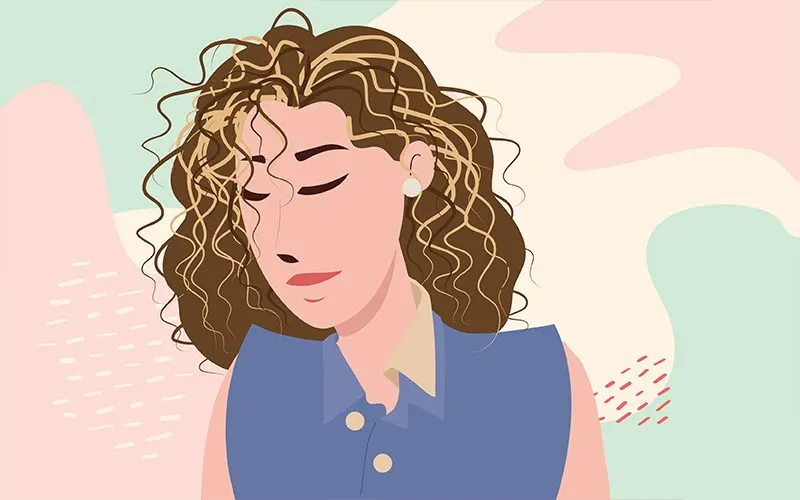
3A hair is curly with a loose S-shape pattern in the curl. The curls are defined and are noticeably springy or bouncy. 3A curls are about as wide as a piece of a wine bottle cork or piece of sidewalk chalk.
If you have 3A hair, your hair’s texture will be either fine (thinner than a thread) or medium (about the same thickness as a thread). 3A hair is not coarse.
Tips for Managing 3A Hair
Common 3A hair problems include dryness and frizz. These problems plague many curl types, but since 3A hair tends to be fine or medium in texture, you have to take a different approach.
Using the right 3A-friendly hair products is a game-changer. The best product choices for 3A hair will be lightweight since your hair texture is fine or medium and can’t handle heavy moisturizers like coarse hair can.
Find a good airy mousse and nourishing hair milk to combat frizz and dryness. We love Design Essentials Natural Curl Enhancing Mousse and milk_shake Incredible Milk for fine, curly hair.
Type 3B Hair

3B hair has a tighter curl than 3A, with curls about as wide as a marker instead of a wine cork. These ringlets are well-defined, usually bouncy, and have the same fine or medium hair texture as 3A hair. 3B curls are tight, but not quite corkscrew tight.
3B hair strands might be thinner than a thread (fine texture) or about the same thickness as a piece of thread (medium texture). It is not typically coarse all over, but it’s common to have some coarser strands mixed in.
Tips for Managing Type 3B Hair
3B hair has the same fine or medium hair texture as type 3A, so the same problems tend to occur: Frizz and dryness. You can combat frizz by addressing the dryness issue. Let’s quickly look at why dryness is a problem for type 3 hair.
The tighter your curl type is, the more bends are present in each hair strand. Since oil (sebum) travels from the scalp down strands to moisturize hair, it has a harder time making its way down super curly strands like type 3B hair.
So the oil isn’t able to do its moisturizing job efficiently, which results in drier hair. You can work around this issue by using lightweight, moisturizing hair products appropriate for type 3B hair.
We love OGX Locking + Coconut Curls Air Dry Cream for 3B hair – it’s light, but with enough moisture and nutrients to satisfy and quench your curls.
Type 3C Hair
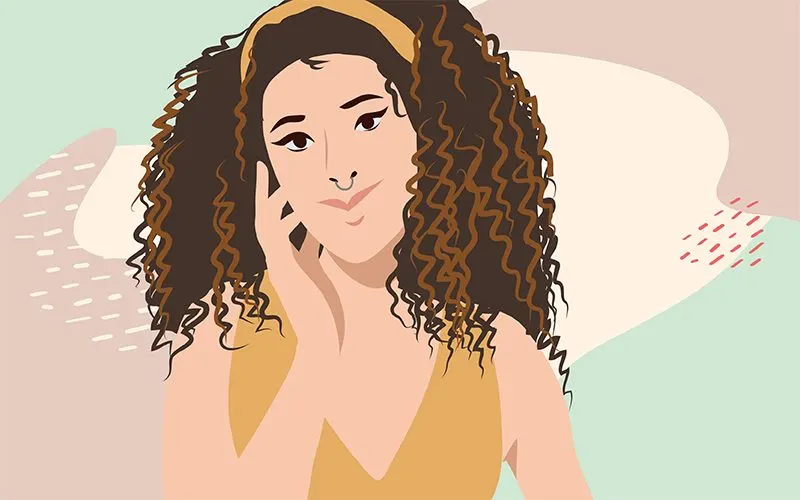
3C hair is the curliest subtype of type 3 hair, and it’s hard to miss. The curl circumference is similar to a straw or pencil. 3C curls resemble corkscrews and are very tight.
No matter how much you stretch or play with 3C curls, they will always bounce back into their original shape. But 3C curls may not always be well-defined in shape to begin with.
In 3C hair, the curls will also be packed closely together. This creates a lot of volume and body. If you have 3C hair, the texture might be fine, medium, or a mixture of medium and coarse.
Tips for Managing Type 3C Hair
3C hair has a lot in common with types 3A and 3B, so it has the same struggles with dryness and frizz as the other curly subtypes. It also struggles with a lack of uniform curl definition, so good curl products with a little hold will be your saving grace.
Since the texture is typically fine, medium, or a mixture of medium and coarse, you should pick a moisturizing product that helps with curl definition.
For fine to medium textured 3C hair, the OGX Locking + Coconut Curls Air Dry Cream is the best. For medium-textured 3C hair with a little coarseness, we like DevaCurl Define and Control Styling Cream.
What Is Type 4 Coily Hair?
Type 4 hair covers coily and kinky hair patterns. Type 4 hair is more tightly coiled than type 3 curly hair, and it’s most common in black women. These ultra-tight curls may have an S-shape, O-shape, or Z-shape, depending on the subtype.
Things you might notice about your type 4 hair:
- The hair forms tight kinks or coils that can be S-, O-, or Z-shaped
- You experience significant shrinkage after drying your hair
- Your hair soaks up moisturizing products very quickly
- Your hair may feel wiry or coarse
- Your hair tends to be dry and fragile
If you think you might have type 4 hair, keep reading to see which subtype your coils fall under.
Type 4A Hair

4A hair is dense and coiled tightly into defined spirals with an S-shape pattern. This is the loosest coil in the type 4 coily/kinky category, but it’s still a very tight coil like a corkscrew. The coil circumference is similar to a coffee stirrer.
4A hair has a lot of volume and body. It tends to hold a similar shape even while it’s wet. It may be finer in texture than it appears, but many women with 4A hair have a coarse or semi-coarse texture.
Tips for Managing Type 4A Hair
4A hair is super-dry and in need of moisture. It’s hard to over-moisturize this hair type because it tends to be more porous. So it drinks up moisture quickly (you’ve probably noticed your moisturizing hair products get absorbed almost instantly).
But it also loses moisture quickly. Managing 4A hair means delivering plenty of moisture deep into strands and using a good curl product to keep those coils defined. If your hair is coarse, it can handle the heaviest moisturizers.
We recommend SheaMoisture Intensive Hydration Masque for moisture (seriously, this stuff is a hydration miracle) and DevaCurl Define and Control Styling Cream for hold in 4A hair.
Type 4B Hair
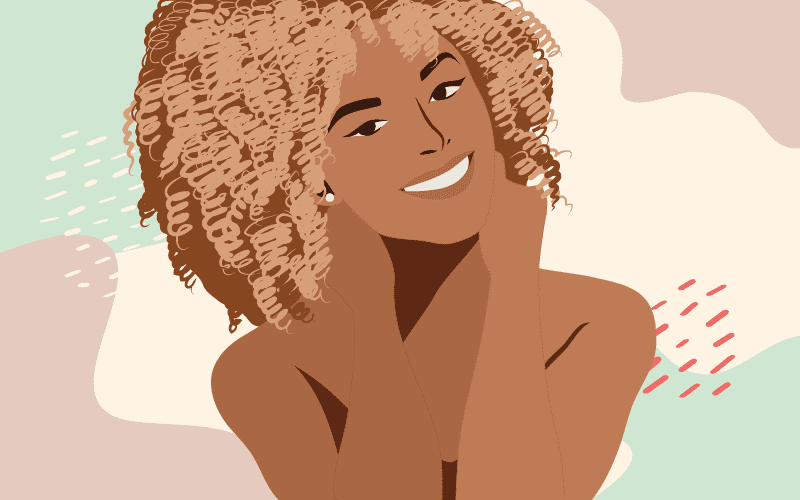
4B hair is very tightly coiled, dense, with less defined coils than type 4A hair. Each coil is about the same circumference as a coffee stirrer. 4B hair has less of the O- or S-shape (common in type 4A) and more of a Z-shape in each coil.
Since individual coils aren’t as defined in this type, the overall look of 4B hair can resemble a mass of textured hair with a few defined coils popping out here and there.
4B hair is known for its zigzag pattern that is wildly different from the looser S-shaped curls we see in type 3 hair.
The bends in 4B hair are more like angles than curves in some cases. Porous 4B hair is prone to shrinkage, meaning it loses much of its length when it dries.
Tips for Managing Type 4B Hair
4B hair is chronically dry and needs hydration to avoid breakage, more shrinkage, and brittleness. Properly moisturizing your 4B hair is the key to keeping it manageable and healthy.
You need hydrating, intensive moisturizing products to continually deliver much-needed moisture to your strands, but there are also a few tricks you can use to amp up hydration.
Try applying a moisturizing oil that can penetrate strands, like coconut oil or castor oil, as a pre-shampoo hydration treatment. Let the oil sit on your hair for about 20 minutes to allow for absorption.
The shampoo will remove any oil remaining on top of your strands, but much of it will have already penetrated deep into your hair for long-lasting moisture.
Type 4C Hair
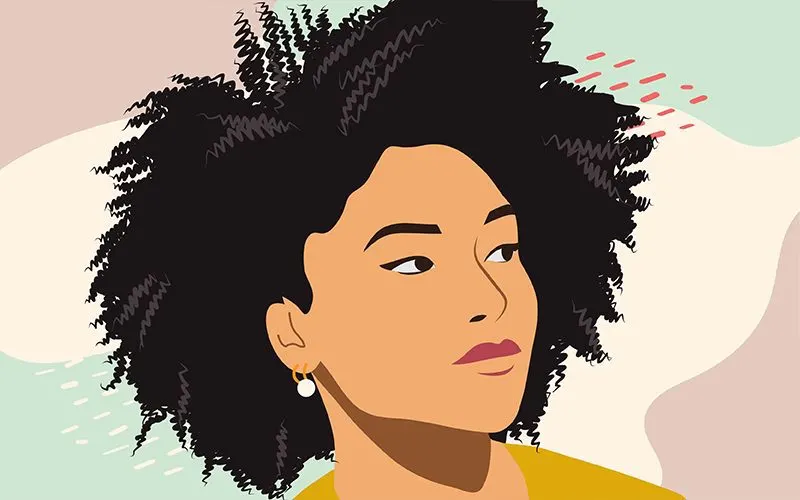
4C hair is the densest, kinkiest hair type and features a tiny zigzag pattern that might not look like curls or coils at a distance. Close up, you can see the angled bends in the strands.
But there are no defined coils formed like with 4A or (to a lesser extent) 4B hair. 4C hair’s biggest issue is shrinkage. Natural 4C hair can shrink as much as 75% when it dries because it loses so much moisture.
Because this hair type is so kinky, it is also chronically dry. This hair type appears as a dense mass of kinked hair with no defined coils when in its raw, natural state.
Tips for Managing Type 4C Hair
4C hair needs copious amounts of moisture to look and feel healthy. Don’t be afraid to overdo it – it’s almost impossible to over-hydrate this hair type.
You should be applying a pre-shampoo oil treatment with coconut oil or your favorite hair oil to avoid further drying out strands when you shampoo.
Opt for ultra-moisturizing shampoos and conditioners for curly hair if you’re a 4C. Every step of your hair care routine should be focused on delivering lots of moisture.
We love Maui Moisture Curl Quench Shampoo and Conditioner for any type 4 hair. Protective styles like braids, dreads, and twists can help prevent damage to your hair and help it retain moisture longer.
Frequently Asked Questions
What are the 4 types of curls?
The 4 main types of curls include Type 1s (straight), Type 2s (wavy), Type 3s (curly), and Type 4s (coily). Within each of these types are subcategories, based on the width of your curl, coil, or wave hair pattern.
What are different types of curls?
The four main types of curls include wavy, loose, tight, and coily. These terms were coined by Ouidad, the first ever hair salon for curly hair. Each curl type is different, meaning each needs its own hair care routine.
Do I have wavy or curly hair?
If your hair has a slight curve to it, it's considered "type 2" wavy. You have "type 3" if the curl is defined or loops. You have "type 4" coily hair if it zig-zags when dried.
What are Type 3A curls?
Type 3A curls have an "S" shape to them along with well-defined loops. In total, the diameter of the loop is about the width of a piece of sidewalk chalk, and have a great deal of volume. However, this type of hair is prone to frizz and dryness.
How do I identify my hair type?
To identify your hair type, simple pluck a strand of dry hair from your head and compare if to this chart. Whichever type of curl looks most like your strand of hair is your hair type.
Which Curl Type Do You Have?
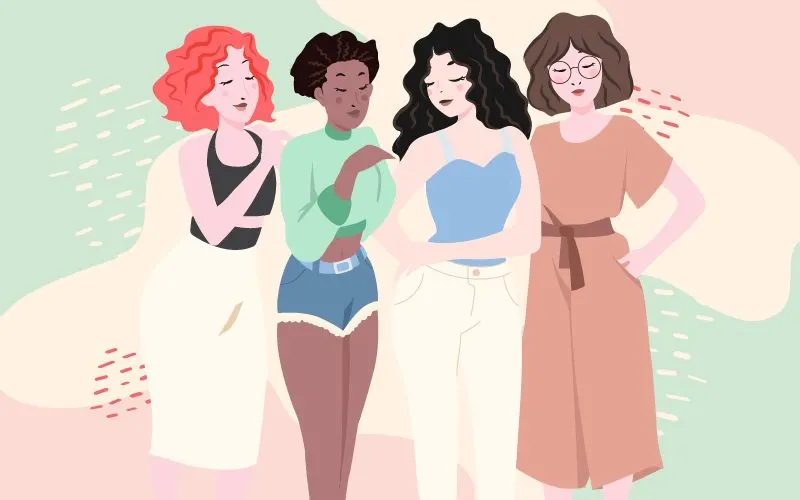
Quick recap! We’ve looked at the two general curly hair types (type 3 curly and type 4 coily or kinky) and their subtypes. Which curl type did you determine you have?
- 3A: Big, loose curls (wine cork size) with fine/medium texture
- 3B: Tighter curls (marker size) with fine/medium texture
- 3C: Tight corkscrew curls (straw size) with fine/medium/coarse texture
- 4A: Defined O- or S-shaped coils (coffee stirrer size) with medium/coarse texture
- 4B: Kinky hair with a less-defined Z-shape pattern and coarse texture
- 4C: Kinky hair with no defined coils, Z-shape pattern, and coarse texture
Isn’t it amazing how much variation there is in curly hair? Two people can both say they have curly hair, but if one is a type 3A and the other is a 4A, those curls will look vastly different.
Now that you know your curl type, you’re one step closer to becoming your own curl expert. Spend some time researching your hair type to learn tips and tricks that will help you make the most of your curly or coily locks.
And no matter what your curl type is, remember to make moisture a priority – just choose moisturizing products that are appropriate (not too light or heavy) for your hair texture.
